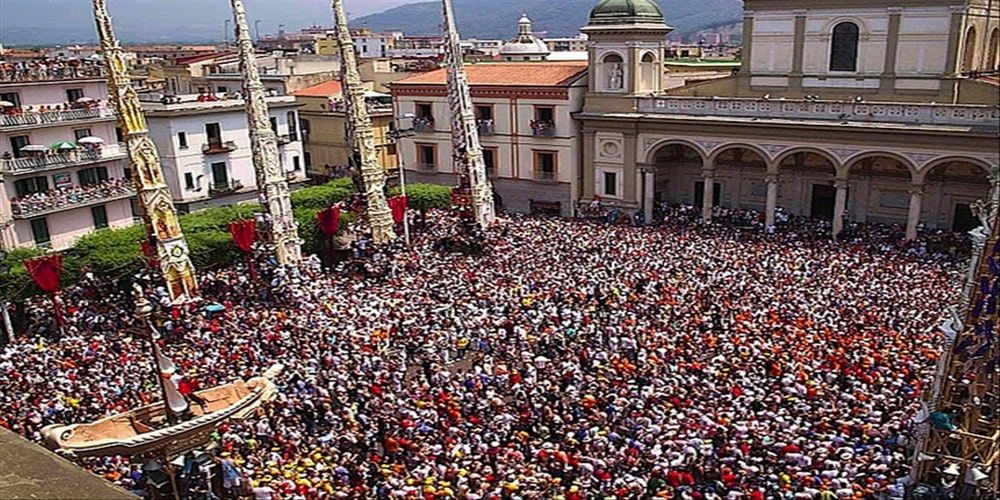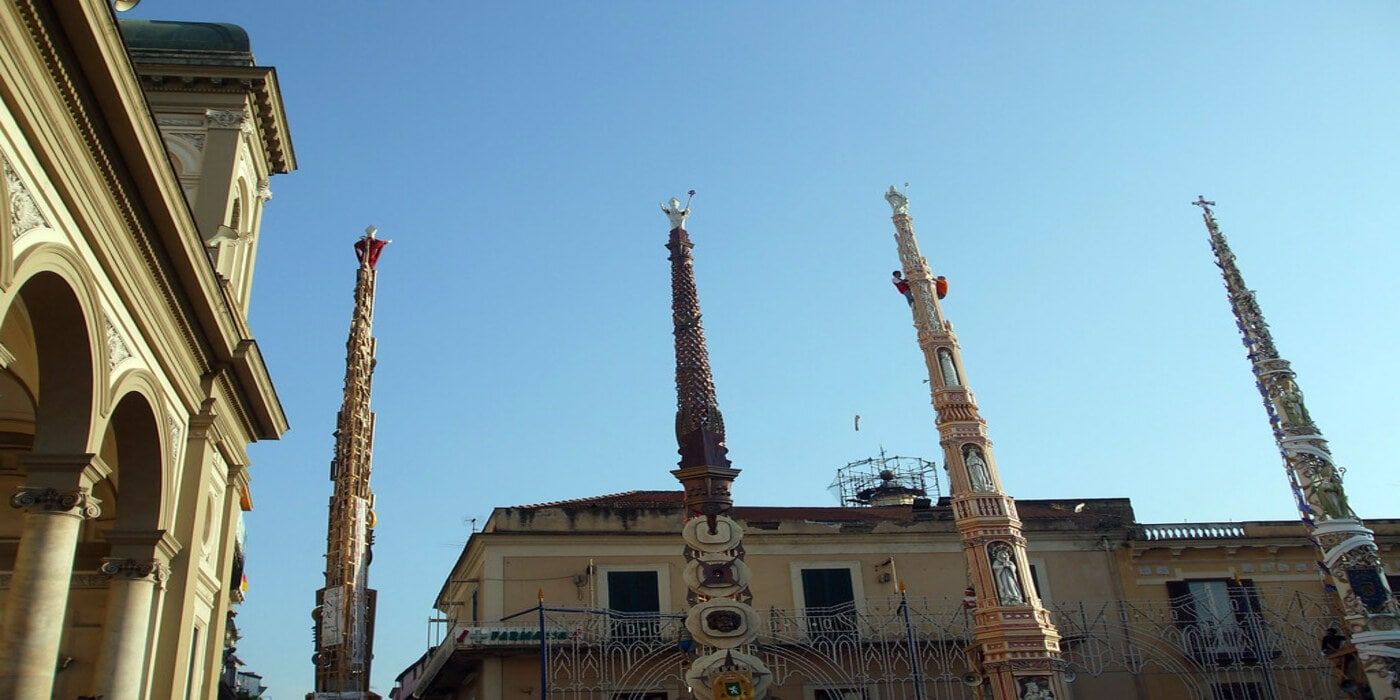The Gigli Feast of Nola is one of the most beloved patronal festivals in the province of Naples and throughout Campania, an appealing event not only for the believers but in general for all those who wish to experience a joyful and cheerful atmosphere while attending the special ceremonies that accompany it - a parade of splendid handcrafted papier-mâché obelisks.
Want to know more about this much-awaited event? Here we tell you in detail what it is all about, the curiosities regarding the overall occasion and its origins: come with us to find out more about the Gigli Feast of Nola.
Find out more about Gigli Feast of Nola 2024
What is the Gigli Feast of Nola?

The Gigli Feast of Nola is celebrated on the day dedicated to St. Paulinus, a much-loved figure among the citizens and crucial during the barbarian invasions of the fifth century AD, a very complex historical period.
The current ritual embracing the occasion has remained virtually unchanged since then, in order to reinforce the connection with that era of crisis but also of rebirth for Nola, and the earliest written sources of it can be found around 1500: it consists of a parade of wood and hand-decorated papier-mâché mobile towers, carried by groups of volunteers, who move to the rhythm of music and compete in the streets and squares, creating a peculiar and impactful setting, a truly unique spectacle. So much so that since 2013, the celebration has been included in the UNESCO World Heritage.
Let's take a look at 5 interesting facts about this event that should not be missed if you love folk festivals.
Discover the Naples surroundings with special transport5. Bishop Paulinus was a true hero
As we said before, Paulinus, later canonized, was the city bishop around the fifth century AD, in the midst of the barbarian invasion era. During the sackings by the Vandals in Nola he sold all his belongings to support those who had lost everything and to provide a ransom for prisoners. According to the legend, when he was unable to redeem the son of a countrywoman who had ended up a prisoner in Africa, he decided to go there and accomplish something practical. He therefore pretended to be a gardener and thus was able to easily infiltrate the court. After ingratiating himself with the ruler and courtiers, Paulinus revealed his identity and predicted the end of the kingdom; the king, frightened by this possibility, freed the prisoners, who returned home.
To thank their brave bishop, the people of Nola organized the procession of the “Consorterie delle arti e dei mestieri” (consortiums of arts and crafts) whose symbol was the lily, the giglio in Italian: it was the first Gigli Feast of Nola in history. That is why, since then, according to tradition, the “flower parade”, each representing a trade, is repeated every year to pay homage to St. Paulinus on his day, June 22.
4. It is a festival "with large machines on the shoulders"
The Gigli are really impressive and sophisticated structures, consisting of the borda, a light wooden bar structure in various sizes, which gives stability without weighing down, for easy transportation.
They are carried on the shoulders by so-called “cullatori”, “cradlers”, whose name refers to the undulating movement they make during transport, to the beat of music. The leader of the group (also known as the paranza, the gang) coordinates movements and is assisted by his corporals, who proceed to the sides and behind the Giglio, while in the center of the structure sits the maestro di festa (master of ceremony), the supervisor, who concretely planned out the performance.
Because of this peculiar parade, the Gigli Feast of Nola is included among the so-called festivals “with large machines on the shoulders”, but it is not the only one: in the province of Naples we find similar ones in neighboring towns such as Barra, Brusciano, Casavatore and Crispano. From this category, outside Campania, we also find the Descent of the Candlesticks in Sassari, the Feast of Santa Rosa in Viterbo, and the Vara of Palmi, in the province of Reggio Calabria.
Explore the province of Naples3. Gigli are handcrafted
The Gigli are built thanks to the synergy of many experts, such as artisans, carpenters, and shipwrights, who are in charge of the wooden base; the covering, on the other hand, is made of papier-mâché, to pay homage to the ancient Nola art of its workmanship, as well as stucco and plaster. The combination of wood and lightweight covering materials makes it rather easy to transport for the parade but at the same time provides stability.
The obelisk dressing is a long, complex and delicate affair that requires the utmost care. A mixture of shredded papier-mâché, glue and plaster baked in hot water is poured into a mold, allowed to dry and extracted, and then applied to a wooden base for further drying. At this point, the handling and welding of the pattern takes place, as well as the plastic composition of different shapes, which can be painted with tempera or watercolors, the final touch that makes the Gigli the artworks that can be admired throughout the parade.
Assembly occurs in stages: it begins by securing the top, usually a statue or pinnacle, by running a rope over a pulley and tying it securely, and thereafter progressively proceed with the elements below, up to the base level.
The themes of the carved and painted subjects on the obelisks are generally sacred or historical, but they also often wink at current events and represent 8 craft and trade guilds - Gardener, Charcuterie, Bartender, Baker, Undertaker, Shoemaker, Blacksmith, Tailor, and Boat, representing the return of St. Paulinus to his homeland from Africa.
2. It is the culmination of a year-long ritual
The Gigli Feast is actually the climax of a year-long process; the master of ceremonies for the following year is chosen only at the end of the festivities and generally based on seniority. The announcement, with the assignment related to the belongign guilde, comes with a fireworks show.
Work proceeds with questues, or fundraisers held in the spring during village lunches and dinners, aiming to support the expenses of obelisk construction - between 60 and 100 thousand euros each.
The hot period is, of course, June, which includes various appointments and events that follow the making process of the Gigli, whose still unadorned framework are fixed in the squares; the weekend before the feast they are gradually completed under the eyes of the citizens - this weekend is called the Feast of the Stripped Gigli and also includes the transport technical tests.
The previous Friday is called Dinner Friday, and open-air dinners are held in the streets, while Saturday includes performances by the committees playing their anthems.
The 22nd is finally the day, featuring the procession of the silver bust of St. Paulinus, a mass in the square and the blessing of the towers by the bishop. In the afternoon, the actual parade with the obelisks through the streets of the city, the Ballad of the Gigli, begins, and it goes on like this, amid music and dancing, until the break of dawn. On Monday, the structures are lined up in front of the town hall, only to be dismantled in the ritual known as 'O colpo 'e core (blow to the heart), which is effectively the first step that opens the following year's festivities: this is precisely why it is said that “a festa tann’ nasc‘ quann’ more” ("the feast is born exactly when it dies”).
1.It is an event incorporating many others
The Gigli Feast of Nola incorporates so many other festivities - processions, parades, dinners, and so on - and that is why in addition to this very important event for the people of Nola, others have sprung up to act as a side dish.
Since last year, moreover, a food village has been set up, where it is possible to taste a multitude of local specialties prepared by the best venues and restaurants in Campania, which, exceptionally, move to Nola with their own stalls. Of course, there is no shortage of local breweries, and wineries, for those who want to accompany their dinner or simply sip local excellence in company.
And also, since music is a fundamental element in accompanying the Gigli parade, concerts by major Campania artists cannot be missed; last year, the headliners included Sal Da Vinci, Eugenio Bennato and Clementino, while this year edition will focus on jazz and mediterranean funky, but artists like Zero Assoluto, 99 Posse and Elettra Lamborghini will be among others on the stage.
In short, the Gigli Feast is not just a procession but an all-around festival, celebrating creativity, love for music and good food, ever-present features in the Campania culture.
Don't forget to try the delicacies of NaplesGigli Feast: celebrating saints and citizens
Like most Italian patronal festivals, the Gigli Feast of Nola represents an ideal meeting of religious and pagan traditions. This particular celebration, according to historians, would be nothing more than the Christianization of a pagan fertility rite, which involved carrying large sacred trees (majo albero) in procession during the summer solstice period.
The sacred is often mixed with the profane, with folklore, and recreates a truly interesting and evocative combination, rituals not to be missed to strengthen the bond with its own roots as well as a time of gathering for the entire citizenry. It is also a tribute to the arts and ancient crafts, craftsmanship and local expertise, which in provincial towns still survive the advance of progress.
The Gigli Feast of Nola awaits you this year as well for the procession and obelisk challenge on June 22, but also before and after with shows and music for all tastes.
About the author
Written on 17/06/2024




Denise Penna
The Gigli Feast of Nola celebrates the beloved St. Paulinus and it's long-awaited event in the province of Naples: here 5 trivia about it.